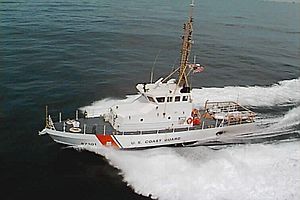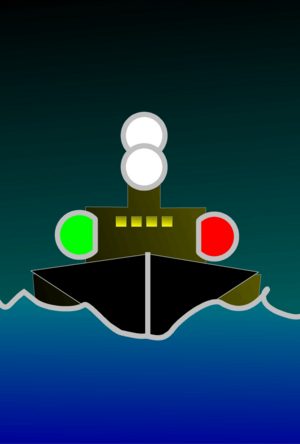Port and starboard facts for kids

When you are on a boat or an airplane, it's important to know your left from your right. But instead of saying "left" and "right," sailors and pilots use special words: port and starboard. Port is always the left side of the vessel when you are looking forward. Starboard is always the right side when you are looking forward. These words are always the same, no matter which way you are facing on the ship. This helps everyone understand directions clearly and avoid confusion.
Where the Names Came From
The word starboard comes from an old English word, steorbord. This word means "the side on which the ship is steered." Long ago, before ships had rudders in the middle, they were steered with a special steering oar. This oar was placed at the back of the ship. Most people are right-handed, so the steering oar was usually on the right side of the boat.
Because the steering oar was on the right side, boats would usually tie up at a wharf (a dock) on the other side. This kept the steering oar from getting in the way. So, the left side of the boat became known as port, which means the side where you load cargo or dock at a port.
For a long time, the left side was actually called larboard. This word came from an old English word related to "load." But larboard sounded very much like starboard. This could cause big problems and confusion, especially in noisy or stormy weather. Because of this, the Royal Navy (the British navy) decided in 1844 that everyone should use the word port instead of larboard. Even after this rule, some whalers continued to use larboard for a few more years.
To help prevent crashes, boats and airplanes have special lights. These lights show which side of the vessel is which, especially at night.
- The port (left) side of a boat or aircraft has a red light.
- The starboard (right) side has a green light.
These lights are placed at the front of the vessel. They help other ships or planes see which way a vessel is going. There are international rules for preventing collisions at sea. These rules say that if two boats are coming close to each other, the boat that sees a red light on its right side must move out of the way. This means if you see a red light on your right, you should turn to avoid a crash.
There's a saying that helps sailors remember what to do:
"If to starboard red appear,
'tis your duty to keep clear...
Green to green, red to red
perfect safety, go ahead."
This means if you see a red light on the right side of another boat, you must change your course. If you see green lights on both boats (green to green), or red lights on both boats (red to red), it means you are likely to pass each other safely.
Images for kids
-
This image from the Bayeux Tapestry shows an old ship called a longship. You can see its steering oar on the starboard (right) side.
See also
 In Spanish: Babor y estribor para niños
In Spanish: Babor y estribor para niños



